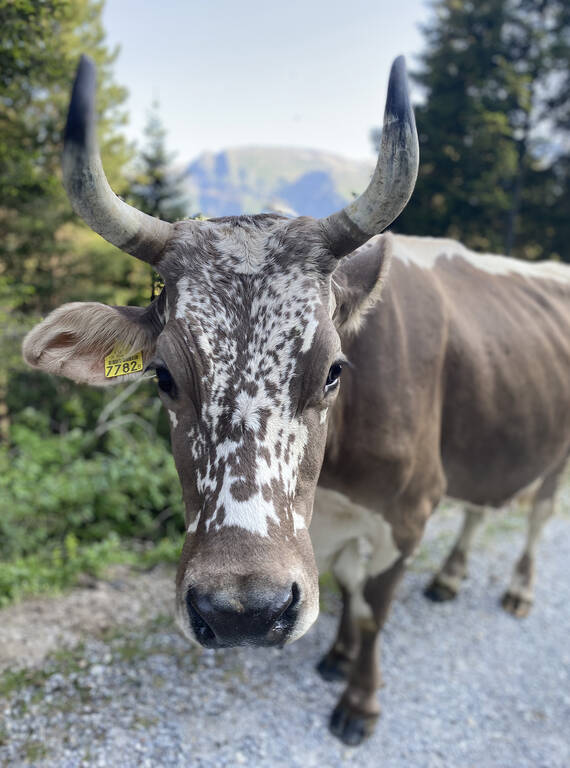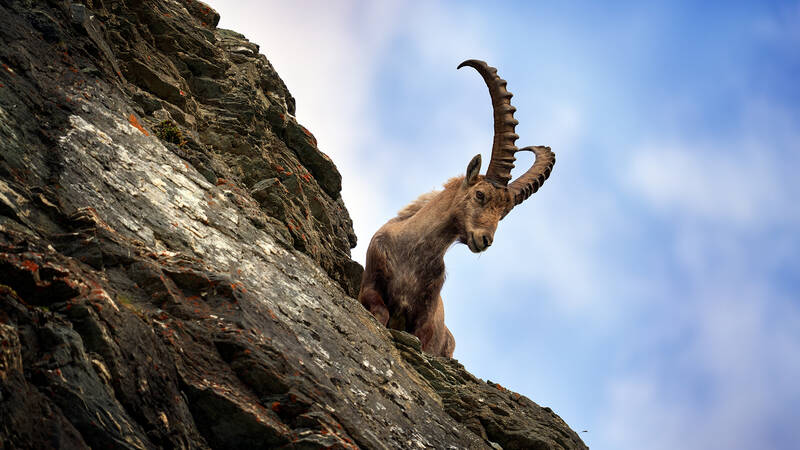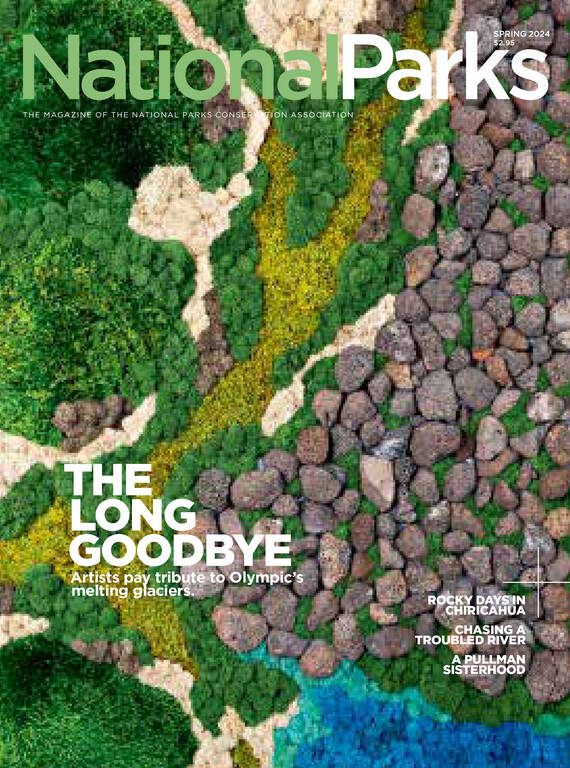Spring 2024
The Swiss Model
Switzerland conveys millions of hikers to alpine landscapes on trains, buses and gondolas. Is a Swiss-like transportation network the solution to overcrowding in U.S. national parks?
The Five Lakes trail just east of the Swiss town of Zermatt was “in a class of its own,” according to the local tourism office, which was quite a statement in a region that may be the most picturesque in a very picturesque country. The online photos of pristine-looking — and deserted — alpine lakes reflecting the triangular silhouette of the Matterhorn seemed to substantiate that claim, and I looked forward to a 6-mile hike with ample opportunities for contemplation.
Getting to the trailhead had been a delight. I had left my rental car in the neighboring town of Täsch and hopped on a train for a 12-minute ride to car-free Zermatt. From there, a funicular ascended through a rock tunnel toward the 7,500-foot-high start of the trail. I imagined a glorious panorama of alpine peaks awaited me at the top.
Switzerland has repeatedly popped up in discussions about overcrowding in national parks in the United States. Many of these parks are accessible primarily by car, and some of the most visible issues associated with increased visitation have included long lines of cars at entrances, traffic jams and overflowing parking lots. So the idea is that if parks and gateway communities offered more public transportation options the way Switzerland does, and potentially made those mandatory, that would go a long way toward solving the crowd problem. On occasion, after hearing that I grew up in Switzerland, people made the same argument directly to me. I’d nod approvingly because I’ve been on enough Swiss trains and buses to know the country boasts a stellar public transportation network, but I also realized I knew next to nothing about whether this kind of approach could work in national parks. So, last summer, on my sabbatical — a benefit NPCA grants staff members after seven years of employment — I decided to see for myself whether the country deserved the accolades for the way it manages access to its public lands.
Fascination with Switzerland’s handling of visitors to its alpine landscapes dates back more than a century. In an essay titled “Making a Business of Scenery,” published in June 1916, Robert Sterling Yard, who along with Stephen Tyng Mather is credited with helping found both the National Park Service and NPCA, wrote: “We want roads and trails like Switzerland’s. … We want lodges and chalets at convenient intervals commanding the scenic possibilities of all our parks.” It was a different time then, and Yard was not trying to limit visitation but to increase it. He bemoaned the fact that while, in his opinion, the beauty of Glacier, Mount Rainier and Rocky Mountain national parks surpassed that of Switzerland, many Americans preferred traveling to the Alps. Over time, Yard’s vision of lodges and roads was largely realized, and the number of visitors shot up to the point that some observers started to say national parks were being “loved to death.” In 1985, my former colleague Laura Loomis wrote in this very magazine that “once-narrow backcountry trails have become hiking highways … and on summer weekends scenic park roads resemble streets during rush hour.” These days, the number of annual visits to the National Park System is well above 300 million, and many individual parks continue to break visitation records.

Not-So-Beaten Paths: 11 Lesser-Known Hikes in Popular National Parks
Hit the trail and avoid the crowds! NPCA staff selected 11 lesser-known hikes in some of the country’s most popular parks.
See more ›The Park Service has used various strategies to mitigate overcrowding, from highlighting lesser-known alternatives to popular sites, to issuing permits for busy trails and promoting shuttle services, but many of the recent measures in the most congested parks have targeted cars. Visitors to Muir Woods National Monument in California must reserve their parking spots beforehand; Acadia National Park now requires reservations for the road to Cadillac Mountain throughout the high season; and under pilot programs at Yosemite, Glacier, Mount Rainier, Rocky Mountain and Arches, drivers must secure timed-entry permits or reservations to enter the parks or visit the most popular areas during the busy months. While recognizing the need for parks to welcome a more diverse group of visitors, NPCA supports these timed-entry systems when appropriate, and Cassidy Jones, NPCA’s senior visitation program manager, noted that the feedback from people who have used them has been “overwhelmingly positive.”
We want lodges and chalets at convenient intervals commanding the scenic possibilities of all our parks.
Since cars are a chief culprit, it’s logical to want to replace them with public transit options. Indeed, a Rocky Mountain historian told me the vast park could accommodate many more visitors if an expanded public transportation network could convey people to the park’s remote corners — and he cited the Swiss example as a model. Angus King, an Independent U.S. senator from Maine, did the same when he convened a hearing about national park overcrowding in 2021. “Many years ago, one of my sons and I had the opportunity to visit the Matterhorn in Zermatt, Switzerland,” he said in his opening remarks. “There are no automobiles in the town whatsoever — and it works.”
Or does it?
When I came out of that Zermatt funicular, my cheery mood quickly soured. It turned out I wasn’t the only one lured by the pretty alpine sights, and the easy access I had enjoyed had been, well, enjoyed by many, many others. The crowd at the top was reminiscent of one you’d see at a mall on a Saturday, and instead of contemplating the beauty of nature, I found myself contemplating our collective trampling of it. I started walking along with the multitude, but after making it to three of the five lakes, I decided that was enough and hurried out of there.
I did find Switzerland’s public transit options marvelous, but at times they were so plentiful that they seemed to compromise the very landscapes they gave access to. Occasionally, I was able to find solitude on the trail, for example at the breathtaking Greina Plateau — an area the Swiss decided not to turn into a national park. But when I visited the country’s most popular alpine destinations, I systematically encountered crowds. In Grindelwald, I was alone on the path toward the Swiss Alps Jungfrau-Aletsch World Heritage Site (except for a herd of cows that accompanied me partway), but I later met hordes of visitors who had traveled there on trains. When I hiked the steep trail toward the Aescher guesthouse in eastern Switzerland, I was pleasantly surprised to pass few others, considering that the inn acquired worldwide fame after National Geographic put it on the cover of its “Destinations of a Lifetime” book. But when I got there, the place was teeming with people, and I realized that while Aescher appears perched on a cliff, it is also easily accessible through a cable car ride and a short downhill walk.

Cows are common on alpine trails in Switzerland.
NPCA/NICOLAS BRULLIARDAbout a third of Switzerland’s 9 million people are regular hikers, and millions of foreign tourists flock to the Swiss mountains annually. Mountain towns are highly dependent on tourism revenue, and placing limits on the number of visitors is pretty much unthinkable. Still, concerns over the impact of “overtourism” are slowly mounting. At Mount Rigi, where cogwheel trains and cable cars ferry 1 million people to the top each year, locals worried the “Queen of the Mountains” was being turned into a kind of alpine Disney World and signed a petition against the construction of a new gondola. The previous owners of the Aescher guesthouse decided to quit because they were overwhelmed by mobs of customers and selfie enthusiasts. “Protected areas are even more likely to suffer from overtourism because they attract large numbers of visitors with promises of pristine nature and unique and idyllic experiences,” wrote Francesco Screti, a researcher at the Université de Fribourg who oversaw a study of how overtourism affects alpine regions. “However, making these places accessible requires additional infrastructure. And if those investments help make tourism more sustainable (by replacing cars with trains, for example), they also provide access to increasing numbers of travelers.”
The Park Service’s mission mandates the agency to preserve parks’ natural resources while providing for the enjoyment of visitors. Reducing the flow of cars in parks is a win on both counts because it decreases car exhaust pollution and the risk of collisions with wildlife, and it lowers the likelihood of traffic jams and competition over limited parking spots. “Getting cars off the roads is something that has a lot of rationale for climate, and it allows just as many people to come through the doors and spend their money, and it reduces the negative visitor experiences of traffic,” said NPCA’s Jones. “But it creates its own problems eventually.”

The writer saw ibex, pictured, as well as marmots, chamois and elk during his time in the Swiss National Park.
©ONDREJPROSICKY/ADOBE STOCKTake Zion National Park. In many ways, the park has adopted a Zermatt-like approach. For most of the year, visitors who want to explore Zion Canyon must leave their cars behind and hop on one of the park’s free shuttles. The shuttle system, funded with money from entrance fees, runs efficiently, with buses showing up every few minutes. But when I visited with my family on a drizzly Thanksgiving Day last year, we waited 40 minutes to get on a bus at the visitor center and another 40 minutes for the return trip. The absence of cars is welcome, but the lines and crowds diminish the visitor experience, and the millions who visit the canyon annually do leave their mark, said Cory MacNulty, NPCA’s campaign director for the Southwest region. “There’s definitely resources impacts in terms of social trailing in the canyon,” she said. “It’s such a concentrated use, and there are some water quality issues when you have so many people in the Virgin River.”

National Parks
You can read this and other stories about history, nature, culture, art, conservation, travel, science and more in National Parks magazine. Your tax-deductible membership donation of $25 or more entitles…
See more ›Each national park’s geography and relative proximity to urban centers will require a specific solution informed by additional visitation management research, which Jones said is badly needed, but individual visitors also have a role to play. Like many others, I’m drawn to Delicate Arch or Yosemite Valley, but over time I’ve realized that I derive far more joy from wandering less populous and wilder landscapes.
During my Swiss odyssey, I found what I was looking for in the Swiss National Park, which was established in 1914. While the park’s peaks are not as high as the Matterhorn, wolves, lynx and bears have all been spotted in its forests of larch and spruce following decades of absence. After a staff member told me that parkgoers are “not allowed to do anything but look and hike,” I left the visitor center and began a one-way trek up to and beyond the 8,350-foot-high Murter Pass. Along the way, I encountered only a dozen hikers (including, oddly, two colleagues of a good friend of mine), but I spotted plenty of marmots, chamois, ibexes and elk — all creatures I hadn’t seen elsewhere on my trip.
The seven-hour hike was a challenging one, but a few minutes after I was done, a shiny and near-empty bus showed up. I climbed aboard, sat down and gazed contentedly out the window as the bus carried me all the way back to the visitor center.
About the author
-
 Nicolas Brulliard Senior Editor
Nicolas Brulliard Senior EditorNicolas is a journalist and former geologist who joined NPCA in November 2015. He writes and edits online content for NPCA and serves as senior editor of National Parks magazine.


